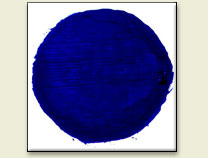
Brief description of Ultramarine:
The finest blue known to the ancients, was obtained from the precious stone lapis lazuli (lazurite), a costly mineral. The mineral lazurite is a complex sodium calcium aluminum silicate sulfate.
Lapis lazuli has been mined for centuries from a location still in use today in the mountain valley of Kokcha, Afghanistan. First mined 6,000 years ago, the rock was transported to Egypt and later to Europe where it was used in jewelry and paint pigment. Europeans called the expensive powdered pigment ultramarine, which literally means over the sea. Since the 19th century, ultramarine has been manufactured artificially
Ultramarine blue is a historical pigment having been found in Egyptian tomb paintings. Raphael, Leonardo da Vinci and Michelangelo Buonarotti used the pigment. Synthetic ultramarine was produced at the beginnig of the nineteenth Century.
Names for Ultramarine:
| Alternative names: | natural variety: lazurite; artificial variety: French ultramarine | ||||||
| Word origin: | The name "Ultramarine" comes from Latin ultra = beyond and mare = sea. | ||||||
| Non-English names: |
|
||||||
| Origin: | natural and artificial | ||||||
| Chemical name: | A complex sulfur-containing sodium aluminum silicate |
Example of use by artists:
 |
The Umbrellas (Les Parapluies)
Renoir, Pierre-Auguste c. 1881-85 This painting was painted during the restless period in Renoir's work. It is immediately apparent that the picture exhibits two distinct styles. The group of figures on the right is painted in a soft feathery style reminiscent of his work of the later 1870s, while the umbrellas and the couple on the left are painted in a harder manner with more distinct outlines and subdued steely colors. The exact date of the painting is not known, but it is generally accepted that it was worked on over a period of several years. Notice how the fashions illustrated in the Umbrellas differs. The women in Renoir's paintings are usually dressed in the latest styles. The dresses and hats worn by the figures at the right conform to a fashion that appeared in 1881 and which became popular in 1882. The vogue was superseded the following year by a more sever style of dress with simple straight lines. THe woman with the band-box is dressed in this latter style which was the height of fashion in 1885-6, but which had fallen out of favor by 1887. Renoir appears to have changed his palette significantly between the two stages. Examination of the cross-sections has shown that in the earlier phase he used exclusively cobalt blue, his habitual choice during the 1870's and early 1880's, but in finishing and revising the composition he used only artificial ultramarine. |
(intro) - Azurite - Cerulean Blue - Cobalt blue - Egyptian blue - Prussian blue - Smalt - Ultramarine

